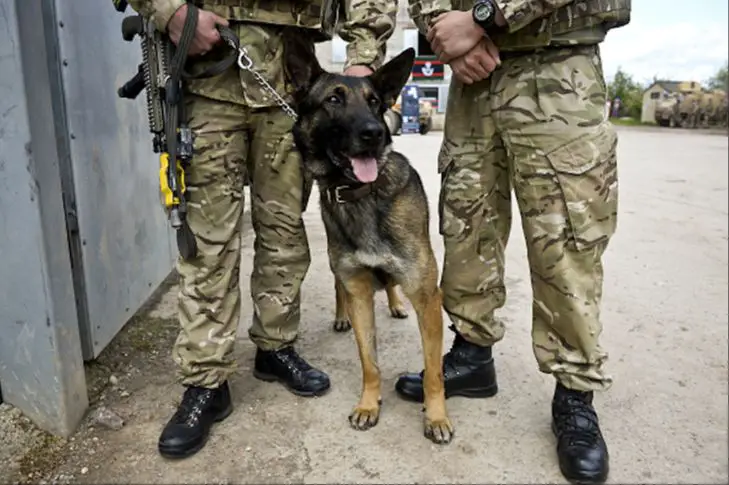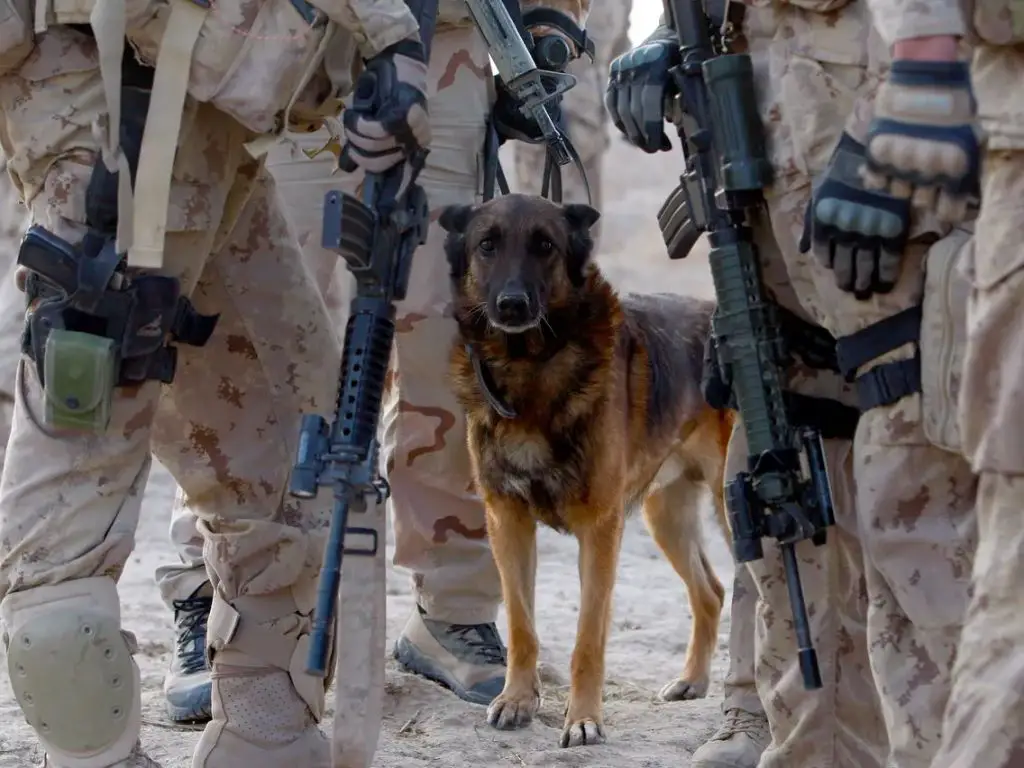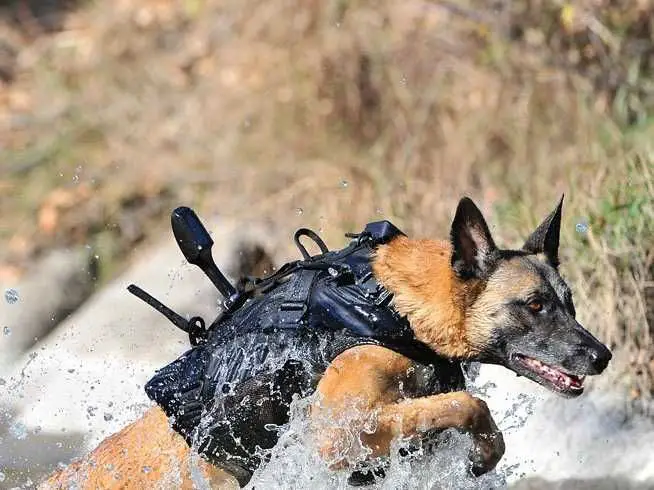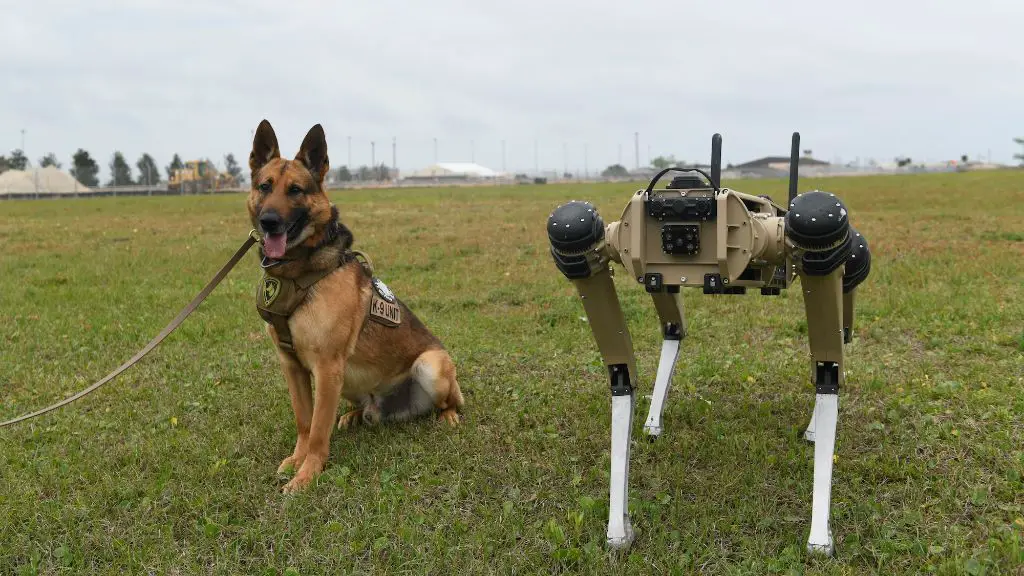Introduction

The United States Navy’s Sea, Air, and Land Teams, commonly known as the Navy SEALs, are among the most elite military forces in the world. SEAL Team 6 in particular carries out high-profile, sensitive missions like the one that resulted in the death of Osama bin Laden. While SEALs are highly trained and capable on their own, they often bring along four-legged assets to help with their missions – military working dogs. These dogs work side-by-side with SEALs, providing vital capabilities such as bomb detection, protection, and tracking. Their partnership with handlers forms an unbreakable bond that is a crucial part of many successful operations. This article will explore the history, training, roles, and future of the dogs that support the Navy’s most elite warriors.
History of Dogs in Warfare
Dogs have been used in warfare for thousands of years. The earliest recorded use of dogs in battle dates back to around 600 BC, when the Lydians used dogs against the Cimmerians [1]. Other early civilizations to employ war dogs include the Egyptians, Greeks, Persians, and Romans.
Dogs were used for sentry and guard duties, tracking, delivering messages, and sometimes even attacking the enemy. Their roles expanded through the Middle Ages into the 19th century. Dogs accompanied Spanish conquistadors in the Americas and were used by European colonizers across the world.
The modern military use of dogs began in the late 19th and early 20th centuries. European militaries officially started training and integrating dogs into their forces before and during World War I. The United States followed suit in 1942, when the War Department created the new position of “K-9 Corps”. [2]
Since then, dogs have served in the armed forces of many countries around the world, assisting with patrols, detection, search and rescue, and more.
Breeds Used by SEAL Team 6
The predominant breed used by SEAL Team 6 is the Belgian Malinois. According to the Navy SEAL Museum, the Malinois is valued for its “confidence, courage, ability to defend itself, high energy drive, obedience to commands, protectiveness of handlers, work drive, and athletic build.” The breed’s compact size, speed, agility, and endurance make it well-suited for parachute jumping and rappelling operations with SEAL teams.
Other breeds sometimes used include the Dutch Shepherd and the German Shepherd. However, the leaner and more athletic Malinois has become the top choice. According to Hepper, the Malinois’ high work drive, trainability, and ability to thrive in harsh conditions make it the ideal SEAL dog. Their strong protective instincts, loyalty, and bonding with handlers provide critical behavioral traits for combat missions and special operations.
Training Dogs for SEAL Team 6
The dogs used by SEAL Team 6 go through extensive training to prepare them for their critical missions. According to Insider, the dogs train at Lackland Air Force Base in Texas, where they learn how to detect explosives, conduct stealth tactical insertions, track down targets, and attack on command. The training regimen lasts for weeks and introduces the dogs to loud noises, gunfire, rappelling from helicopters, riding in zoombags, and parachute jumps to get them accustomed to the conditions of SEAL missions.
The dogs are expertly trained using positive reinforcement methods to follow hand signals and accomplish complex tasks. According to SEALgrinderPT, SEAL dogs learn how to detect tripwires and boobytraps, navigate dangerous terrain at night, and attack hostile targets only on cue from their handler. The rigorous preparation allows the SEAL dogs to operate calmly and precisely even in chaotic combat situations.
Roles of SEAL Dogs
SEAL dogs perform a variety of critical roles for the teams they work with. Some of the main jobs include:

Detection Dogs: These dogs are expert sniffers, using their powerful sense of smell to detect explosives, weapons, and drugs. Their ability to detect even trace smells can save lives by finding hidden dangers. Some common breeds used include German Shepherds and Belgian Malinois.
Attack Dogs: Trained to act aggressively on command, these dogs are used to apprehend and subdue threats. Their speed, power and biting force make them extremely effective for capturing high risk targets. Common breeds include German Shepherds and Dutch Shepherds.
Tracking Dogs: With their superior sense of smell, tracking dogs can locate and follow the trail of specific human scents over long distances and challenging terrain. This allows SEALs to track down fugitives or find lost team members. Bloodhounds are often used for their legendary tracking abilities.
Patrol Dogs: Excellent watchdogs with intimidating presence, patrol dogs walk perimeter lines and help provide security at camp sites or sensitive locations. Their attentiveness and observational skills add an extra layer of protection. Belgian Malinois is a popular patrol dog breed.
Retrieval Dogs: Helping recover items in combat situations, retrieval dogs can sneak into an area undetected and bring back equipment, weapons or other objects to their handlers. Labrador Retrievers are commonly used given their soft mouth and ability to carry.
Based on their strengths and temperaments, each SEAL dog is carefully matched to a specific role that enables them to maximize their contributions to the team. Their specialized skills and natural abilities make them invaluable assets on dangerous missions.
Famous SEAL Dogs
Some of the most well-known dogs used by SEAL teams include:
Cairo – A Belgian Malinois who participated in the SEAL raid that resulted in the death of Osama bin Laden in 2011. Cairo was tasked with searching the compound for hidden threats or explosives (The True Story of the Dog in the Osama bin Laden Mission).
Carlo – A Belgian Malinois who assisted SEAL Team 6 in capturing Ahmed Abu Khattala, the accused ringleader of the 2012 Benghazi attacks, in Libya in 2014 (The Untold Story of the Navy SEAL and Canine Hero Who Caught Bin Laden).
Chopper – A Belgian Malinois who was sent into an Afghan village in 2014 to target bomb makers. He was killed in a firefight, saving the lives of SEAL team members (10 military dogs who made history).
These dogs demonstrated loyalty, bravery, and invaluable service alongside their SEAL team partners during high-stakes missions.
Advantages of Using Dogs

Dogs provide critical advantages for Navy SEAL missions in several key ways:
Detection – Dogs have an incredible sense of smell that can detect explosives, drugs, and hidden enemies from long distances. Their ability to detect threats early is invaluable for SEAL operations. According to Business Insider, dogs can identify prohibited material with over 97% accuracy.
Pursuit – SEAL dogs are exceptionally fast and agile. They can pursue and apprehend fleeing targets more quickly than their human counterparts. Dogs can enter tunnel systems, traverse rugged terrain, and react instantly to threats.
Intimidation – The presence of a SEAL dog alone can intimidate enemies and act as a potent deterrent. Few people want to confront an 80-150 pound trained military dog.
Companionship – SEAL dogs provide crucial companionship and stress relief for isolated operators on long deployments. Bonding with dogs improves morale and mental wellbeing in high-stress environments.
Force Multiplication – Dogs enhance the senses and capabilities of SEAL teams without the need for advanced technology. They allow a small team to achieve greater results by augmenting human limitations.
Overall, SEAL dogs are loyal partners that provide detection, protection, intimidation, pursuit, and companionship. Their unique abilities make them a vital combat multiplier that enhances the safety and success of missions.
Challenges Working with Dogs
Working with military dogs presents some unique challenges. According to a study by Toffoli (2006), some key difficulties include maintaining proper veterinary care, nutrition, and hydration for dogs while deployed. Access to clean water can be limited in certain environments, which is essential for cooling dogs and keeping kennels sanitized. Providing a consistent supply of quality dog food can also pose logistical hurdles.
Additionally, the high operational tempo and extreme conditions take a physical and mental toll on dogs. The intense workload coupled with transportation in loud aircraft can cause stress and anxiety. Weather extremes, difficult terrain, gunfire, and explosions present environmental challenges as well. Lots of training and bonding with handlers helps acclimate dogs to these rigors.
Other concerns include potential communication barriers between dog handlers, vets, and other personnel when operating with multinational forces. Varied levels of experience and cultural perspectives on working dogs can hinder coordination. Despite these difficulties, the military continues to expand and refine canine programs due to their unique capabilities.
Future of SEAL Dogs

The future of SEAL dogs looks promising as the military explores new technologies and capabilities. According to a recent article, the Army is assessing emerging technologies that could simplify training and certifying dogs that detect explosives (1). One technology is a smart harness that can detect dogs’ behavioral and physiological signals, providing feedback to handlers during training. This could optimize and accelerate training.
Another exciting development is AI robot dogs being tested by the Marine Corps (2). These four-legged robots can carry gear and weapons to supplement human-canine teams. While not intended to fully replace real dogs yet, they could take over some routine or dangerous tasks. Robot dogs may one day accompany SEAL teams on missions.
As technology advances, SEAL dogs will likely benefit from innovations like smart wearables, AI integration, and biometrics. The unique capabilities of canine teams will continue evolving to meet future military challenges. But real dogs will remain essential teammates due to their intelligence, adaptability and strong bonding with handlers.
Conclusion
Working dogs play a vital role for military units like SEAL Team 6. Their unique abilities, powerful sense of smell, and exceptional training allow them to support special operations in ways no human could. From tracking down targets to detecting explosives, these dogs have saved countless lives with their service. Their partnership with SEAL handlers demonstrates the incredible things humans and animals can accomplish together. As the nature of warfare evolves, so will the roles filled by military working dogs. Their versatility, intelligence and loyalty ensures they will continue serving on the front lines along with America’s most elite warriors.
